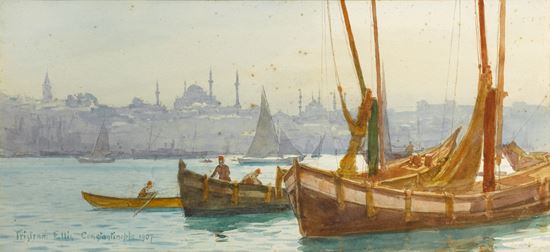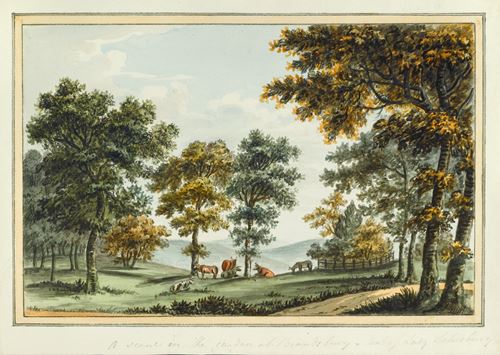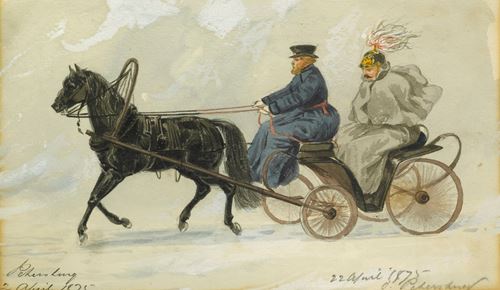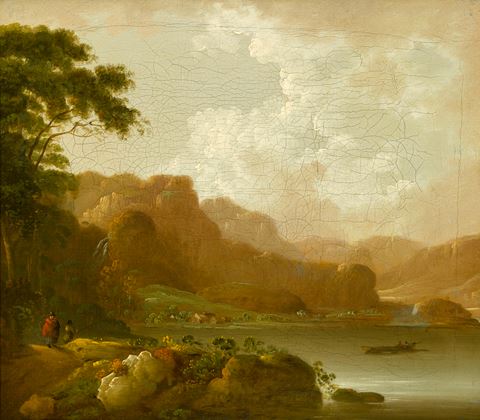ristram Ellis
(Great Malvern 1844 - London 1922)
The Bosphorus, Constantinople
signed, inscribed and dated ‘Tristram Ellis Constantinople 1907’ (lower left)
watercolour
17.2 x 37.3 cm (6¾ x 14¾ in)
The warm glow of the setting sun touches the rippling waters in the centre of this watercolour and the raised sterns of the two moored fishing boats. Behind the boats, the setting light glances off the diverse edifices of Constantinople, on the left, a tower from the Topkapi Palace, and to its right the Hagia Sophia and Blue Mosque.
With their catch already unloaded, two fishermen secure their vessel, laying out the protective fenders, as a caïque-gee arrives beside them to transport them back to the shore. One wonders just how many fish they have managed to coax from the Bosphorus, whose warm waters team with a diverse variety of blue fish. The Bosphorus was the conduit for schools of bonito, which migrated south from the Black Sea to the Sea of Marmara; in the last decades of the nineteenth century in particular, the people of Constantinople would indulge themselves on bonito, which they cooked and served in their fishing boats.
The present watercolour is a typical example of Tristram James Ellis’ work during this period, and the similarities are clear when one compares it to A View of the Galata Bridge, Yemi Cami, Beyazit Tower and Süleymaniye Mosque, Constaninople (Private Collection). The compositions of both works are comparable, with a clear demarcation of foreground and background. The foregrounds are given over to the busy hubbub of the harbour, depicted in shades of red and brown, which stand out against the glimmering surface of the Bosphorus. These depictions of the ordinary and everyday, contrast with the imposing and majestic silhouette of the city which rises up in the background. The slightly hazy depictions of the imperial city reinforces its grandeur, giving it an almost mystical quality.
The Bosphorus, Constantinople is one of many watercolours of Constantinople executed by Ellis. In May 1895, an exhibition of 115 watercolours by Ellis was exhibited at the Japanese Gallery, and featured ‘places that could be easily visited by yacht during a winter in the Mediterranean’. Of the 115 works on display, more than 15 were of views of Constantinople.
Ellis began his career as an engineer working on the District and Metropolitan Railways in London, carrying out several minor engineering projects. In 1874 after deciding to become an artist he entered Bonnat’s studio in Paris to study painting. Four years later he visited Cyprus. This was the first of many journeys that took him to Syria (1880), Egypt (1881-1882), Palestine, Beirut, Jerusalem, Morocco, Greece and Turkey (1885-1886) as well as Russia (1896 and 1898) and Portugal. His extensive travel provided him with the subject matter for most of his paintings and drawings.
Ellis wrote several books including On a Raft and Through the Desert (1881) an account of his journey in 1880 through northern Syria, Kurdistan, and Lebanon, which he illustrated with thirty-eight etchings. Other illustrated books include Egyptian Tales. In 1887 he was elected to the Royal Society.
The warm glow of the setting sun touches the rippling waters in the centre of this watercolour and the raised sterns of the two moored fishing boats. Behind the boats, the setting light glances off the diverse edifices of Constantinople, on the left, a tower from the Topkapi Palace, and to its right the Hagia Sophia and Blue Mosque.
With their catch already unloaded, two fishermen secure their vessel, laying out the protective fenders, as a caïque-gee arrives beside them to transport them back to the shore. One wonders just how many fish they have managed to coax from the Bosphorus, whose warm waters team with a diverse variety of blue fish. The Bosphorus was the conduit for schools of bonito, which migrated south from the Black Sea to the Sea of Marmara; in the last decades of the nineteenth century in particular, the people of Constantinople would indulge themselves on bonito, which they cooked and served in their fishing boats.
The present watercolour is a typical example of Tristram James Ellis’ work during this period, and the similarities are clear when one compares it to A View of the Galata Bridge, Yemi Cami, Beyazit Tower and Süleymaniye Mosque, Constaninople (Private Collection). The compositions of both works are comparable, with a clear demarcation of foreground and background. The foregrounds are given over to the busy hubbub of the harbour, depicted in shades of red and brown, which stand out against the glimmering surface of the Bosphorus. These depictions of the ordinary and everyday, contrast with the imposing and majestic silhouette of the city which rises up in the background. The slightly hazy depictions of the imperial city reinforces its grandeur, giving it an almost mystical quality.
The Bosphorus, Constantinople is one of many watercolours of Constantinople executed by Ellis. In May 1895, an exhibition of 115 watercolours by Ellis was exhibited at the Japanese Gallery, and featured ‘places that could be easily visited by yacht during a winter in the Mediterranean’. Of the 115 works on display, more than 15 were of views of Constantinople.
Ellis began his career as an engineer working on the District and Metropolitan Railways in London, carrying out several minor engineering projects. In 1874 after deciding to become an artist he entered Bonnat’s studio in Paris to study painting. Four years later he visited Cyprus. This was the first of many journeys that took him to Syria (1880), Egypt (1881-1882), Palestine, Beirut, Jerusalem, Morocco, Greece and Turkey (1885-1886) as well as Russia (1896 and 1898) and Portugal. His extensive travel provided him with the subject matter for most of his paintings and drawings.
Ellis wrote several books including On a Raft and Through the Desert (1881) an account of his journey in 1880 through northern Syria, Kurdistan, and Lebanon, which he illustrated with thirty-eight etchings. Other illustrated books include Egyptian Tales. In 1887 he was elected to the Royal Society.





 contact
contact +44 20 7313 8040
+44 20 7313 8040









